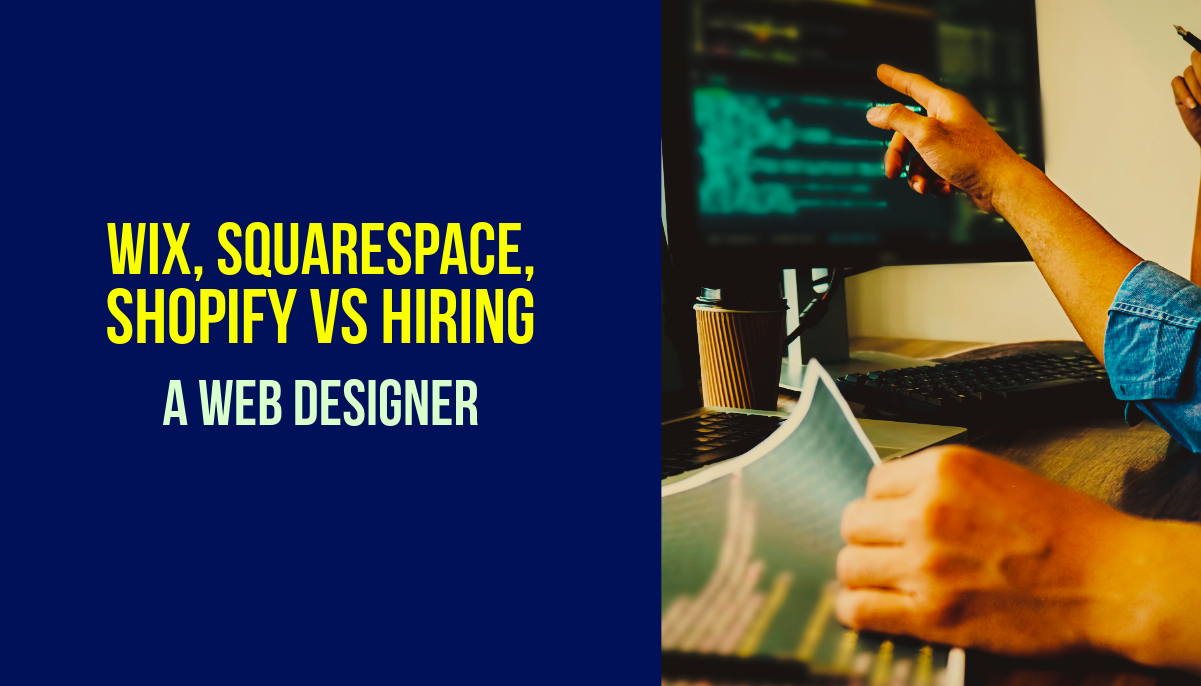Wix, Squarespace, Shopify vs Hiring a Web Designer

Wix, Squarespace, Shopify vs Hiring a Web Designer
The Definitive Guide for Small Business Owners Who Want to Get It Right the First Time
Why This Decision Isn’t Just About Money
Many small business owners start with one simple question:
“Should I just build my website with a platform like Wix or hire someone?”
Seems straightforward, right? Not quite.
What’s often missing from the conversation is what you’re really buying: long-term visibility, user experience, scalability, and whether you’re building a brand or just launching a placeholder.
This article walks you through the real trade-offs, backed by data, business logic, and hands-on experience.
Quick Comparison Table
| Feature | Wix/Squarespace/Shopify | Hiring a Web Designer |
|---|---|---|
| Upfront Cost | Low to Medium | Medium to High |
| Speed to Launch | Very Fast | Depends (2–6 weeks average) |
| SEO Capabilities | Basic to Moderate | Advanced, tailored SEO |
| Design Flexibility | Limited by templates | Fully custom |
| Performance Optimization | Minimal control | Full optimization possible |
| Scalability | Platform-dependent | Fully scalable |
| Ownership | Restricted (platform-locked) | Full ownership |
| Maintenance | Included (SaaS model) | Requires separate support/plan |
DIY Builders: The Good, The Limitations, The Gotchas
Where DIY Platforms Shine:
- Budget-friendly for early-stage startups
- All-in-one solutions (hosting, templates, SSL, etc.)
- Quick launch for MVPs or portfolios
- No coding required
Common Limitations to Watch For:
- Template Lock-in: You can’t fully customize layout behavior without code.
- SEO Shortcomings: Limited schema control, auto-generated tags, and bloated code affect rankings. [Source: Google Search Central Documentation]
- Poor Mobile Optimization: Builders often have breakpoints that don’t adapt to all devices.
- You Don’t Own the Platform: Your entire website lives on rented infrastructure.
- Scalability Pain: You hit a ceiling fast—especially if your business grows or pivots.
Hiring a Web Designer: Why It’s Often Worth It
You’re not just paying for a prettier site. You’re investing in:
- Brand-consistent storytelling
- Custom SEO strategy embedded in the site architecture
- Performance that meets Core Web Vitals (which Google has confirmed affect rankings)
- Ownership and full portability
- Integration with marketing funnels, CRM tools, and analytics
Real Talk: What a Pro Web Designer Brings That DIY Tools Can’t
- Tailored designs that convert, not just “look good”
- Accessibility compliance (AODA/WCAG)—critical for Canadian businesses
- Better tracking setup (Google Analytics 4, Meta Pixel, heatmaps)
- Lean, clean code for site speed and SEO
- Insight into user behavior, calls to action, and buyer psychology
SEO & Google Ads: DIY vs Custom Websites
Google doesn’t care how your site looks—but it does care how it performs.
Google’s Priorities:
- Fast loading times (Core Web Vitals)
- Structured content (schema, proper use of H1/H2s, etc.)
- Secure browsing (HTTPS, no mixed content)
- Mobile responsiveness
- UX signals: bounce rate, engagement time, click-through rate
DIY Builders often fall short on 3+ of those points. Custom sites, on the other hand, can be fine-tuned to meet them all.
SEO vs PPC (Paid Ads) Reality Check:
- DIY Site + Paid Ads = High cost per click, lower quality score
- Pro Site + Organic SEO = Higher quality traffic, better long-term ROI
- Best case? Both—but only if your site supports proper landing page UX.
What-To-Do: Before You Choose
How to Know If DIY Is the Right Fit:
- You’re launching a one-pager or basic info site
- Budget is under $1,000 and can’t stretch
- You need a fast proof-of-concept
- You’re comfortable learning new tech tools
How to Know If You Should Hire a Pro:
- You want to rank on Google and generate leads
- You plan to scale your business over time
- You need your website to reflect your brand positioning
- You want a site that works as a sales tool, not just a brochure
Action Steps
- Start with strategy—what do you need your website to do?
- Write down your must-have features (booking forms, multilingual support, etc.)
- Test a free version of a builder platform—see how far you get
- Consult a professional designer or agency—get a quote and ask what’s included
- Look at Google PageSpeed scores and SEO audits of builder templates vs custom sites
Final Verdict: What’s the Best Path for You?
- Short-term? DIY platforms can get you online quickly.
- Long-term? A professional website is a business asset—not just a digital placeholder.
Think of your website like a storefront.
Would you rather rent a kiosk or build a brand-worthy shop on your own land?
Bonus: Integrating Both Worlds
If you’re tight on budget now, but want to scale later:
- Start with a solid builder on a custom domain
- Collect analytics and customer feedback
- Then upgrade to a professionally designed site once you validate your model
Cited and Trusted Sources
SEO, Core Web Vitals & Google Ranking Factors
- Google Search Central – Core Web Vitals Overview
Use when discussing how Google ranks websites based on page experience. - Google’s SEO Starter Guide (Official)
Reference for basic and advanced SEO best practices—especially relevant to custom websites. - Google Search Central Blog on Mobile-First Indexing
https://developers.google.com/search/blog/2020/03/introducing-mobile-first-indexing
Use when discussing mobile responsiveness and how DIY platforms often underperform here. - Google’s Official PageSpeed Insights Tool
Use this as a recommendation for users to audit their site performance.
DIY Website Builders Limitations & Performance
- Ahrefs: Why Website Builders Hurt Your SEO
Excellent breakdown of how platforms like Wix, Squarespace, and Shopify can hinder long-term SEO growth. - Search Engine Journal: Wix vs WordPress SEO Comparison
https://www.searchenginejournal.com/wix-vs-wordpress-seo/481305/
Use to support points about SEO limitations on builder platforms.


